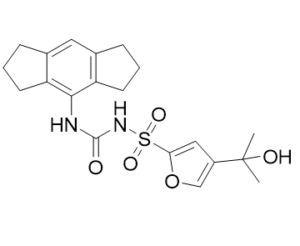MCC950
This product is for research use only, not for human use. We do not sell to patients.

For small sizes, please check our retail website as below: www.invivochem.com
| Size | Price | Stock |
|---|---|---|
| 250mg | $1050 | To Be Confirmed |
| 500mg | $1650 | To Be Confirmed |
| 1g | $2475 | To Be Confirmed |
Cat #: V3786 CAS #: 210826-40-7 Purity ≥ 98%
Description: MCC950 (also known as MCC-950, CP-456773 or CRID3) is a potent, selective, small-molecule inhibitor of NLRP3 that has the potential for the treatment of inflammatory diseases and diabetic encephalopathy (DEP).
Top Publications Citing Invivochem Products
Publications Citing InvivoChem Products
Product Promise

- Physicochemical and Storage Information
- Protocol
- Related Biological Data
- Stock Solution Preparation
- Quality Control Documentation
| Molecular Weight (MW) | 404.48 |
|---|---|
| Molecular Formula | C20H24N2O5S |
| CAS No. | 210826-40-7 |
| Storage | -20℃ for 3 years in powder formrrrrrr |
| -80℃ for 2 years in solvent | |
| Solubility In Vitro | DMSO: >25 mg/mLrrrrrr |
| Water: N/Arrrrrr | |
| Ethanol: N/A | |
| SMILES Code | O=S(C1=CC(C(C)(O)C)=CO1)([N-]C(NC2=C3CCCC3=CC4=C2CCC4)=O)=O |
| Synonyms | CP-45677; CP45677; CP 45677; MCC950; MCC 950; MCC-950; CRID-3; CRID3; CRID 3; CP-456773 |
| Protocol | In Vitro | MCC950 blocks canonical and non-canonical NLRP3 activation at nanomolar concentrations. MCC950 specifically inhibits NLRP3 but not AIM2, NLRC4 or NLRP1 activation. The effect of MCC950 on NLRP3 inflammasome activation is tested in mouse bone marrow derived macrophages (BMDM) and human monocyte derived macrophages (HMDM). The IC50 of MCC950 in BMDM is approximately 7.5 nM, while in HMDM it has a similar inhibitory capacity (IC50=8.1 nM). MCC950 also dose dependently inhibit IL-1β but not TNF-α secretion.MCC950 specifically blocks caspase-11-directed NLRP3 activation and IL-1β secretion upon stimulation of the non-canonical pathway. NLRC4-stimulated IL-1β and TNF-α secretion (as activated by Salmonella typhimurium) are not inhibited by MCC950 even at a concentration of 10 µM. MCC950 does not inhibit caspase-1 activation or IL-1β processing in response to S. typhimurium. The expression of pro-caspase-1 and pro-IL-1β in cell lysates is not substantially affected by MCC950 treatment. |
|---|---|---|
| In Vivo | MCC950 reduces Interleukin-1p (IL-1β) production and attenuates the severity of experimental autoimmune encephalomyelitis (EAE), a disease model of multiple sclerosis. Pre-treatment with MCC950 reduces serum concentrations of IL-1β and IL-6 while it does not considerably decrease the amount of TNF-α. Treatment of mice with MCC950 delays the onset and reduced the severity of EAE. Intracellular cytokine staining and FACS analysis of brain mononuclear cells from mice sacrificed on day 22 shows modestly reduced frequencies of IL-17 and IFN-γ producing CD3+ T cells in MCC950 treated mice in comparison with PBS-treated mice. IFN-γ and particularly IL-17 producing cell numbers are also reduced in both the CD4+ and γδ+ sub-populations of CD3+ T cells. |
These protocols are for reference only. InvivoChem does not
independently validate these methods.
| Solvent volume to be added | Mass (the weight of a compound) | |||
|---|---|---|---|---|
| Mother liquor concentration | 1mg | 5mg | 10mg | 20mg |
| 1mM | 2.4723 mL | 12.3616 mL | 24.7231 mL | 49.4462 mL |
| 5mM | 0.4945 mL | 2.4723 mL | 4.9446 mL | 9.8892 mL |
| 10mM | 0.2472 mL | 1.2362 mL | 2.4723 mL | 4.9446 mL |
| 20mM | 0.1236 mL | 0.6181 mL | 1.2362 mL | 2.4723 mL |
The molarity calculator equation
Mass(g) = Concentration(mol/L) × Volume(L) × Molecular Weight(g/mol)
Mass
=
Concentration
×
Volume
×
Molecular Weight*
The dilution calculator equation
Concentration(start)
×
Volume(start)
=
Concentration(final)
×
Volume(final)
This equation is commonly abbreviated as: C1 V1 = C2 V2
Concentration(start)
C1
×
Volume(start)
V1
=
Concentration(final)
C2
×
Volume(final)
V2
Step One: Enter information below
Dosage mg/kg
Average weight of animals g
Dosing volume per animal µL
Number of animals
Step Two: Enter the in vivo formulation
%DMSO
+
%
+
%Tween 80
+
%ddH2O
Calculation Results:
Working concentration:
mg/ml;
Method for preparing DMSO master liquid:
mg
drug pre-dissolved in
µL
DMSO(Master liquid concentration
mg/mL)
,Please contact us first if the concentration exceeds the DMSO solubility of the batch of drug.
Method for preparing in vivo formulation:
Take
µL
DMSO master liquid, next add
µL
PEG300, mix and clarify, next add
µL
Tween 80,mix and clarify, next add
µL
ddH2O,mix and clarify.
Note:
- (1) Please be sure that the solution is clear before the addition of next solvent. Dissolution methods like vortex, ultrasound or warming and heat may be used to aid dissolving.
- (2) Be sure to add the solvent(s) in order.




































